Last Friday (June 2, 2023), the US Bureau of Labor Statistics (BLS) released their latest labour market data – Employment Situation Summary – May 2023 – which revealed that the the US labour market may be at a turning point but is certainly not contracting at a rate consistent with an eminent inflation. There was a continuing weakening of net employment growth, even though the payroll and survey data were in conflict. The rate of decline though, is currently consistent with an imminent recession. We will see in the June figures whether the slowdown has become a trend.
Overview for May 2023 (seasonally adjusted):
- Payroll employment increased by 339,000 – slightly up on last few months.
- Total labour force survey employment fell by 310 thousand net (-0.19 per cent) – a significant weakening following last month’s slower result.
- The labour force rose 130 thousand net (0.08 per cent).
- The participation rate was unchanged at 62.6 per cent.
- Total measured unemployment rose by 440 thousand to 6,087 thousand.
- The official unemployment rate rose by 0.3 points to 3.7 per cent.
- The broad labour underutilisation measure (U6) rose 0.1 point to 6.7 per cent.
- The employment-population ratio fell 0.1 point to 60.3 per cent (still well below the May 2020 peak of 61.2).
For those who are confused about the difference between the payroll (establishment) data and the household survey data you should read this blog post – US labour market is in a deplorable state – where I explain the differences in detail.
Some months the difference is small, while other months, the difference is larger.
Payroll employment trends
The BLS noted that:
Total nonfarm payroll employment increased by 339,000 in May, in line with the average monthly gain of 341,000 over the prior 12 months. In May, job
gains occurred in professional and business services, government, health care, construction, transportation and warehousing, and social assistance …In May, professional and business services added 64,000 jobs, following an increase of similar size in April …
Government employment increased by 56,000 in May, compared with the average monthly gain of 42,000 over the prior 12 months. Employment in government
is below its pre-pandemic February 2020 level by 209,000, or 0.9 percent.Health care added 52,000 jobs in May, similar to the average monthly gain of 50,000 over the prior 12 months …
Employment in leisure and hospitality continued to trend up in May (+48,000) … remains below its February 2020 level by 349,000, or 2.1 percent.
In May, construction added 25,000 jobs … Over the prior 12 months, construction had added an average of 17,000 jobs per month.
Employment in transportation and warehousing increased by 24,000 in May … Employment in transportation and warehousing has shown no clear trend in recent months.
In May, employment in social assistance rose by 22,000, in line with the average monthly gain of 23,000 over the prior 12 months …
Employment was little changed over the month in other major industries …
In summary, no sign of an impending recession although average monthly job creation in net terms is well down on 2022.
The first graph shows the monthly change in payroll employment (in thousands, expressed as a 3-month moving average to take out the monthly noise). The red lines are the annual averages. Observations between January 2020 and January 2020 were excluded as outliers.
Some sectors, however, have still not regained the employment they lost in 2020-21.
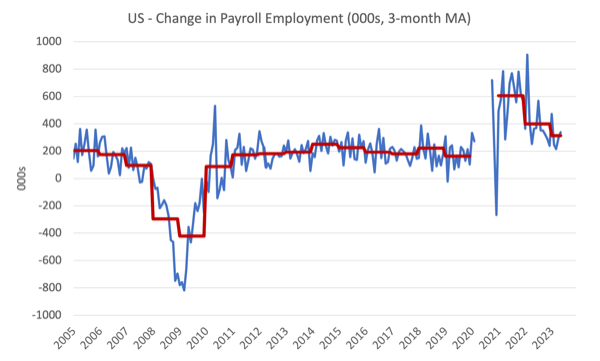
The next graph shows the same data in a different way – in this case the graph shows the average net monthly change in payroll employment (actual) for the calendar years from 2005 to 2023.
The red marker on the column is the current month’s result.
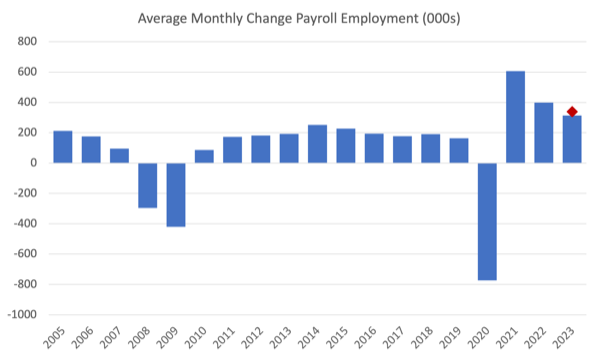
Average monthly change – 2019-2023 (000s)
| Year | Average Monthly Employment Change (000s) |
| 2019 | 163 |
| 2020 | -774 |
| 2021 | 606 |
| 2022 | 399 |
| 2023 (so far) | 314 |
Labour Force Survey data – employment contracts
This month we see a significant discrepancy between the payroll data and the data obtained from the household (labour force) survey. See the link above if you want to understand why this discrepancy arises.
The seasonally-adjusted data for May 2023 reveals:
1. Total labour force survey employment fell by 310 thousand net (-0.19 per cent) – a significant weakening following last month’s slower result.
2. The labour force rose 130 thousand net (0.08 per cent).
3.The participation rate was unchanged at 62.6 per cent.
4. As a result (in accounting terms), total measured unemployment rose by 440 thousand to 6,087 thousand and the official unemployment rate rose by 0.3 points to 3.7 per cent.
Trying to reconcile the payroll and labour survey data this month is difficult but the overall message is that the US labour market is losing steam but not at such a speed that we would expect a recession yet.
The following graph shows the monthly employment growth since January 2008 and excludes the extreme observations (outliers) between May 2020 and January 2020, which distort the current period relative to the pre-pandemic period.
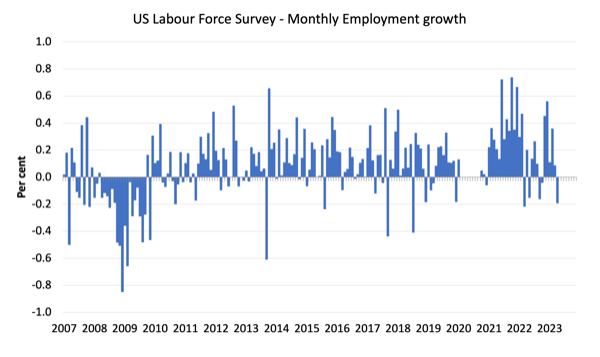
The Employment-Population ratio is a good measure of the strength of the labour market because the movements are relatively unambiguous because the denominator population is not particularly sensitive to the cycle (unlike the labour force).
The following graph shows the US Employment-Population from January 1950 to May 2023.
In May 2023, the ratio fell by 0.1 point to 60.3 per cent – a modest weakening.
The peak level in May 2020 before the pandemic was 61.1 per cent.
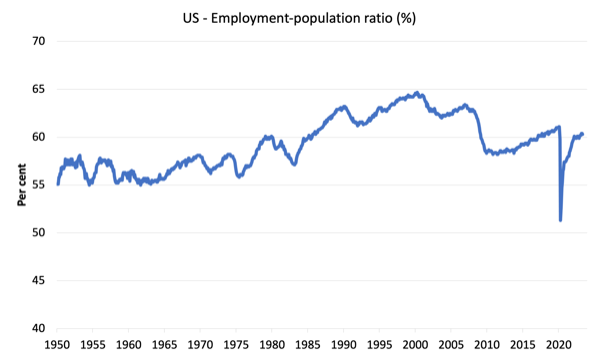
Unemployment and underutilisation trends
The BLS note that:
The unemployment rate increased by 0.3 percentage point to 3.7 percent in May, and the number of unemployed persons rose by 440,000 to 6.1 million. The unemployment rate has ranged from 3.4 percent to 3.7 percent since March 2022 …
The number of long-term unemployed (those jobless for 27 weeks or more) was essentially unchanged at 1.2 million and accounted for 19.8 percent of the total unemployed …
The number of persons employed part time for economic reasons, at 3.7 million, changed little in May. These individuals, who would have preferred full-time employment, were working part time because their hours had been reduced or they were unable to find full-time jobs.
So this month the US labour market shifted from a fairly static picture over the last few months to a slight weakening. We will see next month if a deteriorating trend has set in.
The first graph shows the official unemployment rate since January 1994.
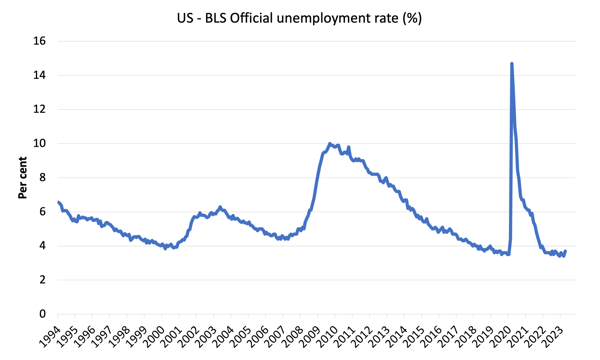
The official unemployment rate is a narrow measure of labour wastage, which means that a strict comparison with the 1960s, for example, in terms of how tight the labour market, has to take into account broader measures of labour underutilisation.
The next graph shows the BLS measure U6, which is defined as:
Total unemployed, plus all marginally attached workers plus total employed part time for economic reasons, as a percent of all civilian labor force plus all marginally attached workers.
It is thus the broadest quantitative measure of labour underutilisation that the BLS publish.
Pre-COVID, U6 was at 6.8 per cent (January 2019).
In May 2023 the U6 measure was 6.7 per cent, up by 0.1 point as a result of the rise in unemployment with other determining factors largely unchanged. It is still 0.2 points above the December 2022 level.
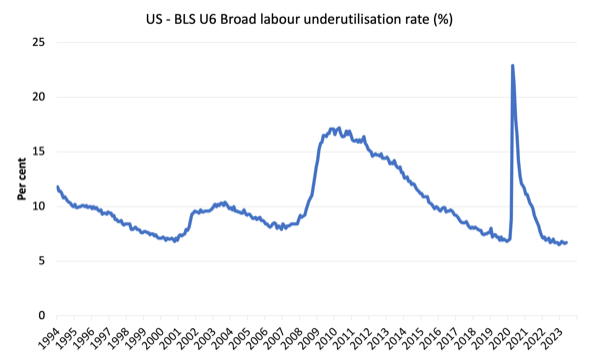
What about wages growth in the US?
The BLS reported that:
In May, average hourly earnings for all employees on private nonfarm payrolls rose by 11 cents, or 0.3 percent, to $33.44. Over the past 12 months, average hourly earnings have increased by 4.3 percent. In May, average hourly earnings of private-sector production and nonsupervisory employees rose by 13 cents, or 0.5 percent, to $28.75.
The latest – BLS Real Earnings Summary – April 2023 (published May 10, 2023) – tells us that:
Real average hourly earnings for all employees increased 0.1 percent from March to April, seasonally adjusted … This result stems from an increase of 0.5 percent in average hourly earnings combined with an increase of 0.4 percent in the Consumer Price Index for All Urban Consumers (CPI-U).
Real average hourly earnings decreased 0.5 percent, seasonally adjusted, from April 2022 to April 2023. The change in real average hourly earnings combined with a decrease of 0.6 percent in the average workweek resulted in a 1.1-percent decrease in real average weekly earnings over this period.
Overall, the inflationary pressures are moderating fast, and nominal wages growth is starting to deliver modest real wage increases. A good sign
The following table shows the movements in nominal Average Hourly Earnings (AHE) by sector and the inflation-adjusted AHE by sector for May 2023 (note we are adjusting using the February CPI – the latest available).
Note that for private employees, real average hourly earnings continue to decline on a monthly basis.
There is also considerable disparity across the sectors, with modest real wage increases starting to show in in most industries in the last month.
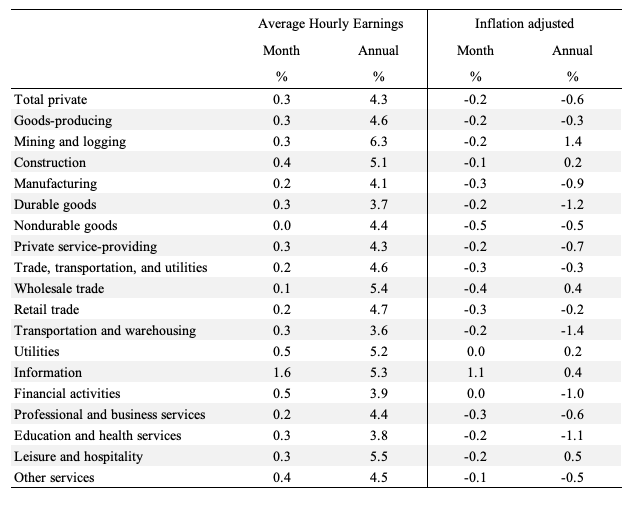
The following graph shows annual growth in real average hourly earnings from 2008 to May 2023.
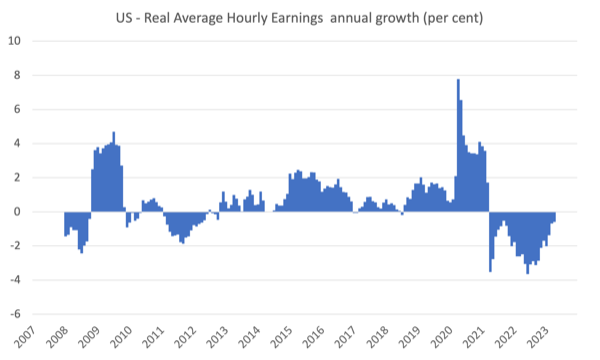
The real wage cuts have slowed and hopefully, workers will start enjoying sustained real wage gains.
The other indicator that tells us whether the labour market is turning in favour of workers is the quit rate.
The most recent BLS data – Job Openings and Labor Turnover Summary (released May 4, 2023) – shows that:
The number of job openings edged up to 10.1 million on the last business day of April … Over the month, the number of hires changed little at 6.1 million. Total separations decreased to 5.7 million. Within separations, quits (3.8 million) changed little, while layoffs and discharges (1.6 million) decreased …
In April, the number and rate of quits changed little at 3.8 million and 2.4 percent, respectively.
So as of April 2023, the quit rate was not yet in retreat. We will see if the May 2023 data indicates a slowdown is becoming entrenched.
Conclusion
In May 2023, the latest US labour market data revealed no signs of a looming recession although there was a continuing weakening of net employment growth, even though the payroll and survey data were in conflict.
Overall, the US labour market may be at a turning point but is certainly not contracting at a rate consistent with an imminent recession.
We will see in the June figures whether the slowdown has become a trend.
That is enough for today!
(c) Copyright 2023 William Mitchell. All Rights Reserved.

